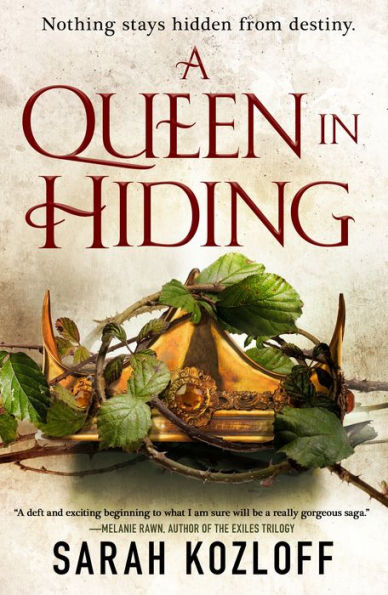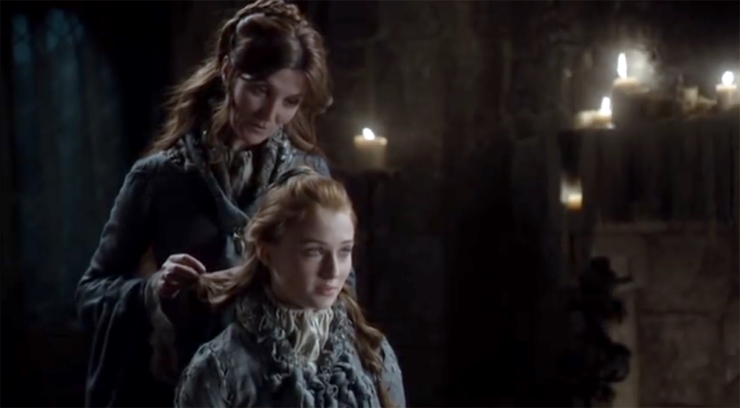I get the problems that come with including mothers; I really do. No self-respecting mother would allow her daughter to carry the ring back to Mordor, and no young woman—say Katsa in Graceling—would want her mother to come along on her missions. (When my sons were self-conscious middle-schoolers they would squirm with embarrassment if I even talked to anyone at the bus stop.)
If our stories trace journeys of self-discovery, our protagonists may need to be free of the fetters of family.
Lots of people have noticed the general lack of mothers in SFF. (See, for instance, Aliette de Bodard.) I’d like to add that if mothers appear at all, oddly, they seem to have borne only male children or primarily to have invested their energies in guarding a patrilineal line.
Something mysterious happened to make female babies rare, and it goes as far back as Penelope and Telemachus in the Odyssey. Think of Lady Jessica in Dune, Queen Kettricken in Robin Hobb’s Farseer series, or the royal mothers in Abercrombie’s The Shattered Sea and Schwab’s A Darker Shade of Magic. On the screen, we have Sarah Connor in Terminator II and Joyce Byers in Stranger Things protecting their precious sons. (I’m still angry with Catelyn Stark because she sits by Bran’s bedside and follows Rob’s army, but outsources the care of her daughters to a nursemaid and Lady Brienne.)
So, of the four possible relationships—father-son, father-daughter, mother-son, and mother-daughter—the last is the least common in SFF.
Moreover, if you do find a mother-daughter duo, chances are there’s something “off” about the pair. Something goes awry almost the moment it appears, no matter which of the pair is the more important character.
The Weak Mother: She creates a vacuum that the daughter is thus allowed to fill with her superior strength and independence. Katniss Everdeen’s mother has become incapacitated by her losses, leaving Katniss alone to try to save her sister and herself. Kaul Wan Ria in Jade City completely removes herself from the No Peak clan, forcing her daughter to navigate its treacheries without her help. In Naomi Novik’s Spinning Silver, Miryem’s mother can’t repair the family’s fortunes, nor protect her daughter from the Staryk (though she does provide a nurturing presence for Wanda, the abused village girl). In the del Toro version of Pan’s Labyrinth, Ophelia’s pregnant mother sickens and dies. (Exit mother, stage left.)
Unplanned Separations: In Butler’s Parable of the Talents, religious zealots kidnap Larkin as a baby, and Lauren and Larkin are kept apart throughout the book. The same happens to Essun and Nassun in The Broken Earth. Mrs. Murray, in A Wrinkle in Time, makes a great impression as a brilliant scientist who simultaneously cooks dinner over a Bunsen burner and intuitively knows the right thing to say to all her children. But she isn’t included in the expedition to save her husband. Kate Elliott’s Jessamy, who appears in Court of Fives, is taken away from her mother and sisters. (Act II: New location, sans mother.)
Abandonment for Higher Causes: Diana, in the movie Wonder Woman, leaves her mother and the Edenic island to fight evil in the world of men. Tasha Suri’s Empire of Sand features a mother who deserts her daughters to help her clan, causing the protagonist deep pain. By contrast, in Outlander (TV version), Claire Randall, who is the lead character, temporarily renounces her grand passion with Jamie to stay in the 20th century, raising their child in safety and comfort. As soon as she grows up, Clare chooses Jamie and the 18th century. (Someone exits, stage right.)
The Alternative Mother/The Substitute Daughter: Older women often are allowed to be strong and have good relationships with a younger woman only if the female they care for isn’t actually their daughter. Fairy godmothers, foster mothers, grandmothers, or aunts serve as surrogates. See, for instance, The Mists of Avalon, Tehanu, or The Wizard of Oz. Of course, there’s always the possibility that the new maternal figure could turn out to be a wicked stepmother. (Enter understudy characters.)
Perhaps you know counter examples that I have yet to discover. But I can’t help wondering why these relationships are both doubly rare and then further attenuated. Why are writers who set out to portray mothers and daughters—I include myself here—somehow blocked from portraying richer or longer-lasting duos?
Habits of mind create an all-encompassing fog, creeping everywhere, clouding our vision. Especially since many fantasies are set in a pre-modern world, based on historical eras, canonical literary models, or Western mythology, it just feels “natural” to follow patriarchal patterns. Fathers and sons get to bond together against enemies, fathers get to bless their daughters and give them away to their suitors, and mothers get to stay home and support their sons or melt away.
Even our language betrays us: when I imagined a country where the throne passed down matrilineally, I kept having to remind everyone it was not a “kingdom.”
Another aspect of patriarchal culture is pitting women against one another. Perhaps SFF writers have been affected by the much-psychoanalyzed friction between mothers and daughters, those legendary battles over individuation vs. dependency, envy vs. loyalty, competition vs. devotion. Creating this particular parent-child relationship wanders into territory already made fraught by all the changing expectations and conflicting commands over how a “good” mother should behave or what a daughter “ought” to do with her life and her body. Mothers come with extra emotional baggage.
So, do these hexed relationships matter?
Buy the Book


A Queen in Hiding
The absence of richly drawn partnerships between mothers and daughters in SFF creates at least two major problems. First, our stories give the impression that the only way for a woman to be a hero is to leave her family; they present a model of independence and self-sufficiency that may be neither necessary nor desirable. Secondly, this absence deprives readers (young and old, of whatever gender) of models of female solidarity, just at a time when we need these models the most.
Although this problem is bigger than one corner of the bookstore, my impression is that in recent decades other genres have tried harder to remedy this lack. For instance, I happen to know that in romantic comedies, whereas the screwball heroines of the 1930s seemed mostly to have sprung from the head of Zeus, memorable mother figures support their grown daughters in Moonstruck (1987), As Good as It Gets (1997), Momma Mia! (2008), and Crazy Rich Asians (2018). And in so-called “women’s fiction”—I dislike the inference that the whole rest of the canon is for men—you can find mother-daughter relationships foregrounded in novels by, for instance, Amy Tan, Jodi Picoult, Anna Quinlan, or Elizabeth Strout.
“But,” someone might say, “rom-coms and women’s fiction deal with domestic, family matters and they presume a female audience, but SFF shows us adventures, quests, voyages, wars, or even societies with alternate forms of identity and reproduction. And SFF novels are pitched to all genders.”
That’s precisely why SFF should be more inclusive.
SFF authors can imagine so many wondrous things, is it really so hard to imagine mothers and daughters? With the freedom inherent in SFF, authors should be able to create worlds where daughters have as much independence as sons, mothers as much power and prestige as fathers—and where both of them can have each other’s backs, facing threats together.
Sarah Kozloff is a Vassar film professor turned novelist, author of the epic fantasy quartet, The Nine Realms. Book one, A Queen in Hiding, publishes January 21, 2020 with Tor Books.










